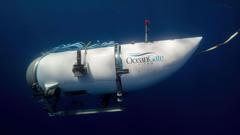Was the Titan Implosion That Killed Five Preventable?

Understanding the Tragic OceanGate Titan Submersible Disaster
The implosion of the OceanGate Titan submersible on June 18, 2023, was a disaster that shook the maritime community and raised numerous questions about safety protocols in deep-sea exploration. Following a comprehensive investigation, the U.S. Coast Guard has categorized the incident as "preventable," highlighting critical flaws in OceanGate's safety practices. This article delves into the findings of the Coast Guard's report, examining the key takeaways and exploring the implications for the future of deep-sea exploration.
Summary of the Incident
The Titan submersible was on a mission to explore the wreckage of the Titanic when it disappeared during its descent into the Atlantic Ocean. Tragically, all five individuals onboard lost their lives due to a catastrophic implosion that occurred approximately 90 minutes into the dive. The Coast Guard's investigation revealed that the primary causal factor for this disaster was OceanGate's failure to adhere to established engineering protocols for safety and testing.
Key Findings of the Coast Guard Report
The investigative report, spanning 335 pages, outlines several critical findings regarding OceanGate's operational practices. Here are five key takeaways:
- Inadequate Safety Practices: The report condemns OceanGate's safety protocols as fundamentally inadequate. Investigators found glaring disparities between the company's written safety protocols and their actual practices, leading to the conclusion that the marine casualty was preventable.
- Neglect of Maintenance and Inspection: OceanGate failed to follow proper maintenance and inspection protocols for the Titan submersible. Despite previous incidents that compromised the craft's integrity, the company continued to use the sub without adequately assessing its suitability for deep-sea dives.
- Structural Failures: The investigation determined that the Titan's carbon-fiber hull suffered a catastrophic loss of structural integrity under the immense pressure of nearly 5,000 pounds per square inch. The crew died instantly during this horrific event.
- Regulatory Evasion: The report accuses OceanGate of intentionally avoiding regulatory scrutiny by leveraging intimidation tactics and exploiting regulatory confusion. This strategic manipulation allowed the company to operate outside established deep-sea protocols.
- Accountability of Leadership: Stockton Rush, the founder of OceanGate and pilot of the Titan during its ill-fated voyage, was found to have exhibited negligence contributing to the disaster. Had he survived, investigators indicated they would have recommended criminal charges against him.
Implications of the Findings
The findings from the Coast Guard's report carry significant implications for the future of deep-sea exploration. Here are some considerations to keep in mind:
1. Need for Stronger Oversight
The report emphasizes the need for enhanced regulatory oversight in the submersible industry. Jason Neubauer, chair of the Coast Guard Marine Board, highlighted the importance of clear options for operators exploring new concepts outside the existing regulatory framework. This call for stronger oversight aims to prevent similar tragedies in the future.
2. Reevaluation of Materials Used
Carbon fiber, while popular in various industries, has demonstrated reliability issues under extreme pressure. The report indicates that this material should be reevaluated for use in deep-sea submersibles. Experts, including Rob McCallum from EYOS Expeditions, have pointed out the unpredictable nature of carbon fiber and the dangers it poses when subjected to the stresses of deep-sea environments.
3. Importance of Independent Oversight
The consolidation of power within OceanGate's leadership structure proved detrimental to safety. Neubauer pointed out the risks of a CEO also serving as the safety officer and lead engineer, which can lead to a lack of checks and balances. Independent oversight is crucial in ensuring safety protocols are followed and that there is accountability at all levels of an organization.
Safety Recommendations for Future Exploration
In light of the investigation, the Coast Guard Marine Board issued 14 safety recommendations aimed at improving safety standards within the submersible industry. These recommendations include:
- Implementing stricter oversight and regulations for submersible operations.
- Conducting regular maintenance and inspection of submersible vessels, particularly those using innovative materials.
- Establishing independent safety boards to review and approve deep-sea exploration missions.
- Enhancing training and certification programs for personnel operating submersibles.
- Creating a standardized reporting system for incidents and near-misses to aid in future safety improvements.
OceanGate's Response
In response to the tragedy and the subsequent investigation, OceanGate expressed its condolences to the families of the victims and stated that it has wound down operations to fully cooperate with the Coast Guard's inquiry. The company has acknowledged the findings of the report and the need for improved safety practices moving forward.
Conclusion
The OceanGate Titan submersible disaster serves as a stark reminder of the importance of safety in deep-sea exploration. The Coast Guard's report reveals critical flaws in operational protocols and highlights the need for stronger oversight and accountability within the industry. As we look to the future of underwater exploration, it is vital that lessons are learned from this tragedy to prevent similar incidents from occurring. What steps do you think should be taken to improve safety in deep-sea exploration? #OceanGate #SafetyFirst #DeepSeaExploration
Frequently Asked Questions
What caused the Titan submersible to implode?
The Titan submersible imploded due to a catastrophic loss of structural integrity of its carbon-fiber hull, which was unable to withstand the extreme pressure at deep-sea levels.
How many people were on board the Titan when it imploded?
There were five individuals on board the Titan submersible at the time of the implosion, all of whom tragically lost their lives.
What were the main findings of the Coast Guard report regarding OceanGate?
The main findings included inadequate safety practices, neglect of maintenance and inspections, regulatory evasion tactics, and accountability issues with leadership, particularly concerning Stockton Rush.
What recommendations were made to prevent future incidents?
The Coast Guard made 14 safety recommendations, including implementing stricter oversight, conducting regular maintenance inspections, and establishing independent safety boards for submersible operations.
How did OceanGate respond to the tragedy?
OceanGate expressed condolences to the families of the victims and stated it has wound down operations to cooperate fully with the Coast Guard's inquiry into the incident.
Published: 2025-08-05 18:14:04 | Category: technology



